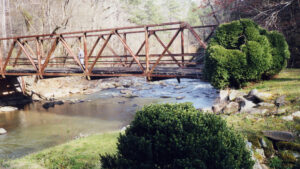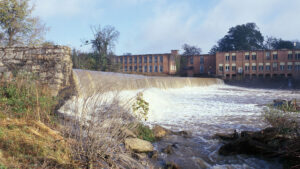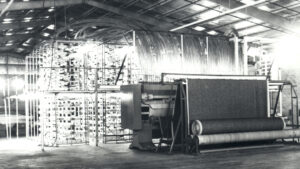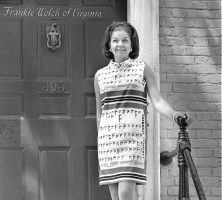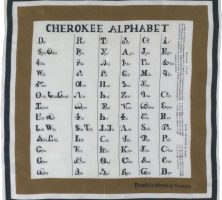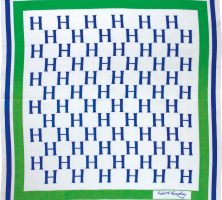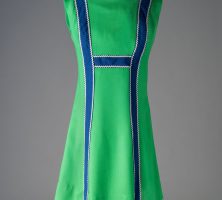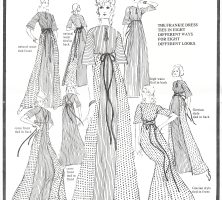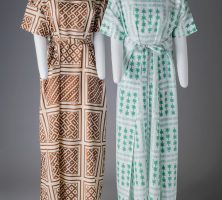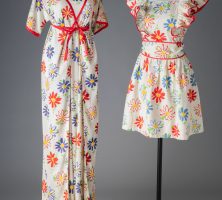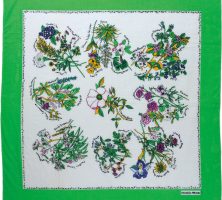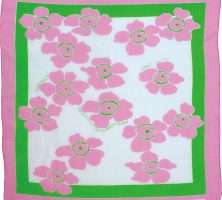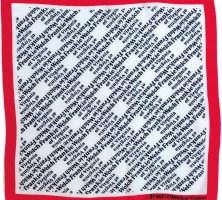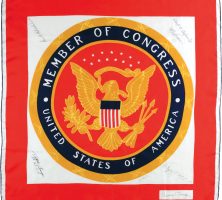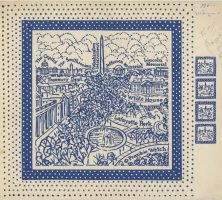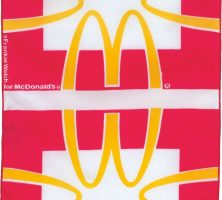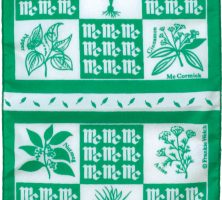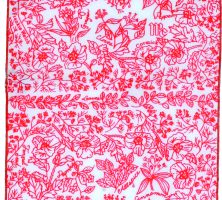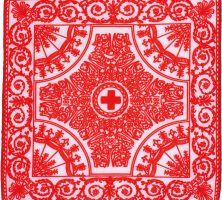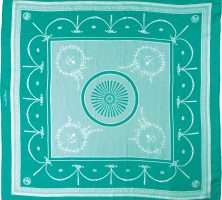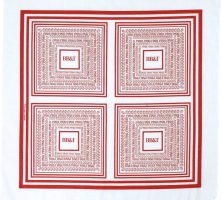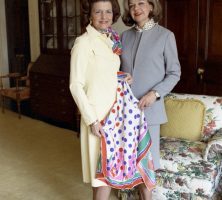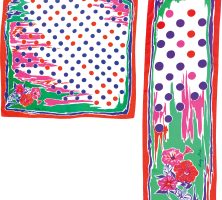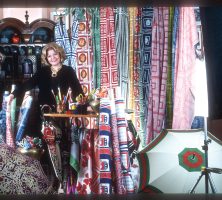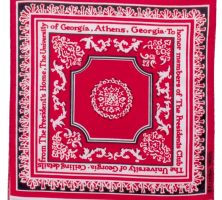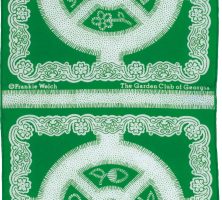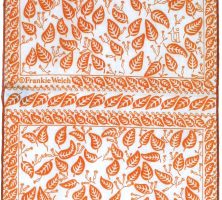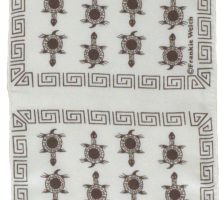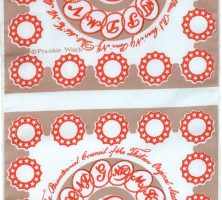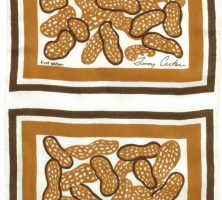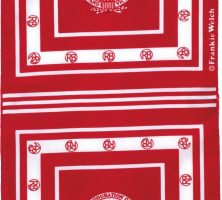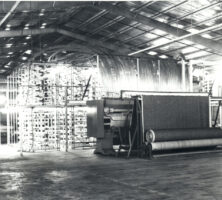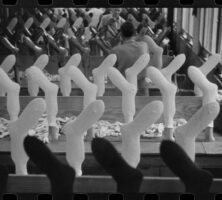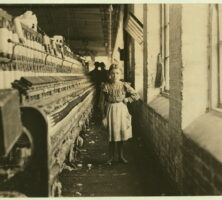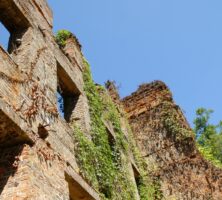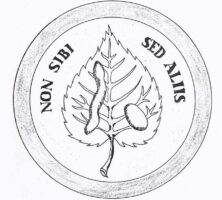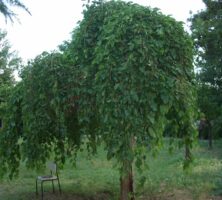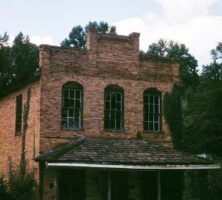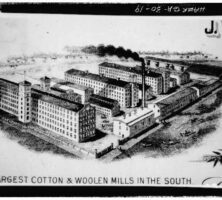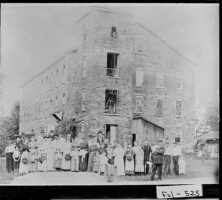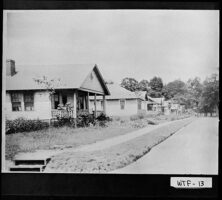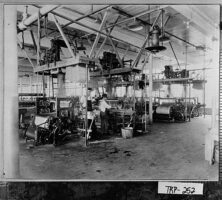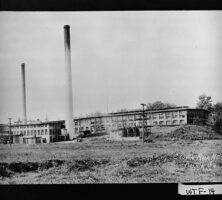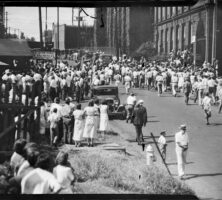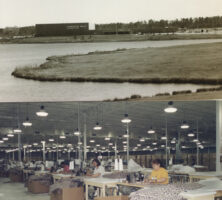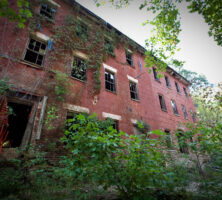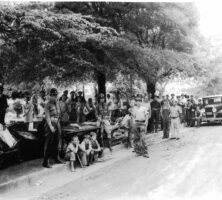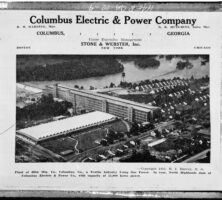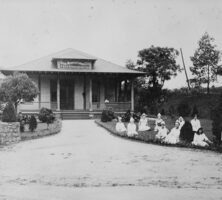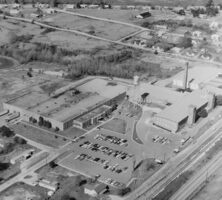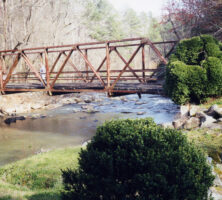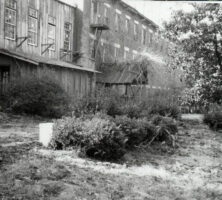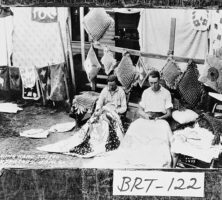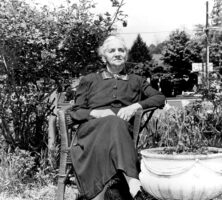The New Georgia Encyclopedia is supported by funding from A More Perfect Union, a special initiative of the National Endowment for the Humanities.
Frankie Welch wearing a Cherokee Alphabet dress in front of Duvall House, Alexandria, Virginia, 1968.
Courtesy of Hargrett Rare Book and Manuscript Library, University of Georgia Libraries, Collection of Frankie Welch, Peggy Welch Williams, and Genie Welch Leisure.
The New Georgia Encyclopedia does not hold the copyright for this media resource and can neither grant nor deny permission to republish or reproduce the image online or in print. Requests for permission to publish or reproduce the resource should be submitted to the Hargrett Manuscript and Rare Book Library at the University of Georgia.
Cherokee Alphabet scarf, 1967, silk.
Courtesy of Hargrett Rare Book and Manuscript Library, University of Georgia Libraries, Frankie Welch Textile Collection.
The New Georgia Encyclopedia does not hold the copyright for this media resource and can neither grant nor deny permission to republish or reproduce the image online or in print. Requests for permission to publish or reproduce the resource should be submitted to the Hargrett Manuscript and Rare Book Library at the University of Georgia.
Discover America scarf, ca. 1968, unidentified fabric.
Courtesy of Hargrett Rare Book and Manuscript Library, University of Georgia Libraries, Frankie Welch Textile Collection.
The New Georgia Encyclopedia does not hold the copyright for this media resource and can neither grant nor deny permission to republish or reproduce the image online or in print. Requests for permission to publish or reproduce the resource should be submitted to the Hargrett Manuscript and Rare Book Library at the University of Georgia.
Hubert H. Humphrey scarf, 1968, silk.
Courtesy of Hargrett Rare Book and Manuscript Library, University of Georgia Libraries, Frankie Welch Textile Collection.
The New Georgia Encyclopedia does not hold the copyright for this media resource and can neither grant nor deny permission to republish or reproduce the image online or in print. Requests for permission to publish or reproduce the resource should be submitted to the Hargrett Manuscript and Rare Book Library at the University of Georgia.
Hubert H. Humphrey dress, 1968.
Courtesy of Ashley Callahan
The New Georgia Encyclopedia does not hold the copyright for this media resource and can neither grant nor deny permission to republish or reproduce the image online or in print. All requests for permission to publish or reproduce the resource must be submitted to the rights holder.
Frankie flyer, ca. 1975.
Courtesy of Hargrett Rare Book and Manuscript Library, University of Georgia Libraries, Collection of Frankie Welch, Peggy Welch Williams, and Genie Welch Leisure.
The New Georgia Encyclopedia does not hold the copyright for this media resource and can neither grant nor deny permission to republish or reproduce the image online or in print. Requests for permission to publish or reproduce the resource should be submitted to the Hargrett Manuscript and Rare Book Library at the University of Georgia.
Basket Weave Frankie and Turtles Frankie, n.d.
Courtesy of Hargrett Rare Book and Manuscript Library, University of Georgia Libraries, Frankie Welch Textile Collection.
The New Georgia Encyclopedia does not hold the copyright for this media resource and can neither grant nor deny permission to republish or reproduce the image online or in print. Requests for permission to publish or reproduce the resource should be submitted to the Hargrett Manuscript and Rare Book Library at the University of Georgia.
Republican National Convention Frankie and pinafore, 1968.
Courtesy of Hargrett Rare Book and Manuscript Library, University of Georgia Libraries, (left) Frankie Welch Collection, Rome Area History Center and (right) Frankie Welch Textile Collection, Hargrett Rare Book and Manuscript Library, University of Georgia Libraries.
The New Georgia Encyclopedia does not hold the copyright for this media resource and can neither grant nor deny permission to republish or reproduce the image online or in print. Requests for permission to publish or reproduce the resource should be submitted to the Hargrett Manuscript and Rare Book Library at the University of Georgia.
Models wearing Clyde’s scarf and tie, ca. 1976.
Courtesy of Hargrett Rare Book and Manuscript Library, University of Georgia Libraries, Collection of Frankie Welch, Peggy Welch Williams, and Genie Welch Leisure.
The New Georgia Encyclopedia does not hold the copyright for this media resource and can neither grant nor deny permission to republish or reproduce the image online or in print. Requests for permission to publish or reproduce the resource should be submitted to the Hargrett Manuscript and Rare Book Library at the University of Georgia.
Fifty State Flowers scarf, 1970, cotton.
Courtesy of Hargrett Rare Book and Manuscript Library, University of Georgia Libraries, Collection of Frankie Welch, Peggy Welch Williams, and Genie Welch Leisure.
The New Georgia Encyclopedia does not hold the copyright for this media resource and can neither grant nor deny permission to republish or reproduce the image online or in print. Requests for permission to publish or reproduce the resource should be submitted to the Hargrett Manuscript and Rare Book Library at the University of Georgia.
National Cherry Blossom Festival, Washington, D.C., scarf, 1970, unidentified fabric.
Courtesy of Hargrett Rare Book and Manuscript Library, University of Georgia Libraries, Frankie Welch Collection, Rome Area History Center.
The New Georgia Encyclopedia does not hold the copyright for this media resource and can neither grant nor deny permission to republish or reproduce the image online or in print. Requests for permission to publish or reproduce the resource should be submitted to the Hargrett Manuscript and Rare Book Library at the University of Georgia.
Frankie Welch of Virginia scarf, 1969, silk.
Courtesy of Hargrett Rare Book and Manuscript Library, University of Georgia Libraries, Frankie Welch Textile Collection.
The New Georgia Encyclopedia does not hold the copyright for this media resource and can neither grant nor deny permission to republish or reproduce the image online or in print. Requests for permission to publish or reproduce the resource should be submitted to the Hargrett Manuscript and Rare Book Library at the University of Georgia.
Member of Congress scarf, 1969, silk.
Courtesy of Hargrett Rare Book and Manuscript Library, University of Georgia Libraries, Frankie Welch Collection, Historic Clothing and Textile Collection, College of Family and Consumer Science, University of Georgia.
The New Georgia Encyclopedia does not hold the copyright for this media resource and can neither grant nor deny permission to republish or reproduce the image online or in print. Requests for permission to publish or reproduce the resource should be submitted to the Hargrett Manuscript and Rare Book Library at the University of Georgia.
Washington, D.C., scarf design, ca. 1978.
Courtesy of Hargrett Rare Book and Manuscript Library, University of Georgia Libraries, Collection of Frankie Welch, Peggy Welch Williams, and Genie Welch Leisure.
The New Georgia Encyclopedia does not hold the copyright for this media resource and can neither grant nor deny permission to republish or reproduce the image online or in print. Requests for permission to publish or reproduce the resource should be submitted to the Hargrett Manuscript and Rare Book Library at the University of Georgia.
McDonald’s scarf, 1976, Qiana.
Courtesy of Ashley Callahan
The New Georgia Encyclopedia does not hold the copyright for this media resource and can neither grant nor deny permission to republish or reproduce the image online or in print. All requests for permission to publish or reproduce the resource must be submitted to the rights holder.
McCormick scarf, 1977, Qiana.
Courtesy of Hargrett Rare Book and Manuscript Library, University of Georgia Libraries, Frankie Welch Textile Collection.
The New Georgia Encyclopedia does not hold the copyright for this media resource and can neither grant nor deny permission to republish or reproduce the image online or in print. Requests for permission to publish or reproduce the resource should be submitted to the Hargrett Manuscript and Rare Book Library at the University of Georgia.
McCormick scarf, 1978, polyester.
Courtesy of Hargrett Rare Book and Manuscript Library, University of Georgia Libraries, Frankie Welch Textile Collection.
The New Georgia Encyclopedia does not hold the copyright for this media resource and can neither grant nor deny permission to republish or reproduce the image online or in print. Requests for permission to publish or reproduce the resource should be submitted to the Hargrett Manuscript and Rare Book Library at the University of Georgia.
Red Cross napachief, 1981, unidentified synthetic fabric.
Courtesy of Hargrett Rare Book and Manuscript Library, University of Georgia Libraries, Frankie Welch Textile Collection.
The New Georgia Encyclopedia does not hold the copyright for this media resource and can neither grant nor deny permission to republish or reproduce the image online or in print. Requests for permission to publish or reproduce the resource should be submitted to the Hargrett Manuscript and Rare Book Library at the University of Georgia.
National Treasures (Mount Vernon) scarf, 1993, silk.
Courtesy of Hargrett Rare Book and Manuscript Library, University of Georgia Libraries, Collection of Frankie Welch, Peggy Welch Williams, and Genie Welch Leisure.
The New Georgia Encyclopedia does not hold the copyright for this media resource and can neither grant nor deny permission to republish or reproduce the image online or in print. Requests for permission to publish or reproduce the resource should be submitted to the Hargrett Manuscript and Rare Book Library at the University of Georgia.
BB&T bandana, n.d., cotton.
Courtesy of Hargrett Rare Book and Manuscript Library, University of Georgia Libraries, Collection of Frankie Welch, Peggy Welch Williams, and Genie Welch Leisure.
The New Georgia Encyclopedia does not hold the copyright for this media resource and can neither grant nor deny permission to republish or reproduce the image online or in print. Requests for permission to publish or reproduce the resource should be submitted to the Hargrett Manuscript and Rare Book Library at the University of Georgia.
Betty Ford and Frankie Welch with the Betty Ford scarf, 1975.
U.S. National Archives and Records Administration, U.S. National Archives and Records Administration.
The New Georgia Encyclopedia does not hold the copyright for this media resource and can neither grant nor deny permission to republish or reproduce the image online or in print. All requests for permission to publish or reproduce the resource must be submitted to the rights holder.
Betty Ford scarf/scarves, 1975, Qiana.
Courtesy of Hargrett Rare Book and Manuscript Library, University of Georgia Libraries, Collection of Frankie Welch, Peggy Welch Williams, and Genie Welch Leisure.
The New Georgia Encyclopedia does not hold the copyright for this media resource and can neither grant nor deny permission to republish or reproduce the image online or in print. Requests for permission to publish or reproduce the resource should be submitted to the Hargrett Manuscript and Rare Book Library at the University of Georgia.
Frankie Welch, 1987.
Courtesy of Hargrett Rare Book and Manuscript Library, University of Georgia Libraries, Collection of Frankie Welch, Peggy Welch Williams, and Genie Welch Leisure.
The New Georgia Encyclopedia does not hold the copyright for this media resource and can neither grant nor deny permission to republish or reproduce the image online or in print. Requests for permission to publish or reproduce the resource should be submitted to the Hargrett Manuscript and Rare Book Library at the University of Georgia.
University of Georgia scarf for the President’s Club, 1982, polyester.
Courtesy of Ashley Callahan
The New Georgia Encyclopedia does not hold the copyright for this media resource and can neither grant nor deny permission to republish or reproduce the image online or in print. All requests for permission to publish or reproduce the resource must be submitted to the rights holder.
Garden Club of Georgia scarf, 1978, polyester.
Courtesy of Hargrett Rare Book and Manuscript Library, University of Georgia Libraries, Frankie Welch Textile Collection.
The New Georgia Encyclopedia does not hold the copyright for this media resource and can neither grant nor deny permission to republish or reproduce the image online or in print. Requests for permission to publish or reproduce the resource should be submitted to the Hargrett Manuscript and Rare Book Library at the University of Georgia.
Tobacco Institute scarf, 1978, cotton.
Courtesy of Hargrett Rare Book and Manuscript Library, University of Georgia Libraries, Frankie Welch Textile Collection.
The New Georgia Encyclopedia does not hold the copyright for this media resource and can neither grant nor deny permission to republish or reproduce the image online or in print. Requests for permission to publish or reproduce the resource should be submitted to the Hargrett Manuscript and Rare Book Library at the University of Georgia.
Turtles scarf, designed ca. 1971, Qiana.
Courtesy of Hargrett Rare Book and Manuscript Library, University of Georgia Libraries, Collection of Frankie Welch, Peggy Welch Williams, and Genie Welch Leisure.
The New Georgia Encyclopedia does not hold the copyright for this media resource and can neither grant nor deny permission to republish or reproduce the image online or in print. Requests for permission to publish or reproduce the resource should be submitted to the Hargrett Manuscript and Rare Book Library at the University of Georgia.
Thirteen Original States scarf, designed 1975, Qiana.
Courtesy of Hargrett Rare Book and Manuscript Library, University of Georgia Libraries, Collection of Frankie Welch, Peggy Welch Williams, and Genie Welch Leisure.
The New Georgia Encyclopedia does not hold the copyright for this media resource and can neither grant nor deny permission to republish or reproduce the image online or in print. Requests for permission to publish or reproduce the resource should be submitted to the Hargrett Manuscript and Rare Book Library at the University of Georgia.
National Press Club scarf, 1973, unidentified fabric.
Courtesy of Hargrett Rare Book and Manuscript Library, University of Georgia Libraries, Collection of Frankie Welch, Peggy Welch Williams, and Genie Welch Leisure.
The New Georgia Encyclopedia does not hold the copyright for this media resource and can neither grant nor deny permission to republish or reproduce the image online or in print. Requests for permission to publish or reproduce the resource should be submitted to the Hargrett Manuscript and Rare Book Library at the University of Georgia.
Peanut scarf for Governor and Mrs. Jimmy Carter, 1973, silk.
Courtesy of Ashley Callahan
The New Georgia Encyclopedia does not hold the copyright for this media resource and can neither grant nor deny permission to republish or reproduce the image online or in print. All requests for permission to publish or reproduce the resource must be submitted to the rights holder.
Scarf for the inauguration of Ronald Reagan and George H. W. Bush, 1980, polyester.
Courtesy of Hargrett Rare Book and Manuscript Library, University of Georgia Libraries, Frankie Welch Textile Collection.
The New Georgia Encyclopedia does not hold the copyright for this media resource and can neither grant nor deny permission to republish or reproduce the image online or in print. Requests for permission to publish or reproduce the resource should be submitted to the Hargrett Manuscript and Rare Book Library at the University of Georgia.
Georgia Libraries Association scarf, 1971, Qiana.
Courtesy of Hargrett Rare Book and Manuscript Library, University of Georgia Libraries, Frankie Welch Textile Collection.
The New Georgia Encyclopedia does not hold the copyright for this media resource and can neither grant nor deny permission to republish or reproduce the image online or in print. Requests for permission to publish or reproduce the resource should be submitted to the Hargrett Manuscript and Rare Book Library at the University of Georgia.
While the introduction of new machinery to textile factories in the 1970s resulted in workforce reductions across the state, the carpet industry of north Georgia weathered such changes, producing around 80 percent of the world's carpets in the twenty-first century.
Courtesy of Carpet and Rug Institute
The New Georgia Encyclopedia does not hold the copyright for this media resource and can neither grant nor deny permission to republish or reproduce the image online or in print. All requests for permission to publish or reproduce the resource must be submitted to the rights holder.
A hosiery mill at Union Point, in Greene County, produces socks in 1941. Textile mills in Georgia began producing a variety of cotton products, including hosiery, carpet yarn, and twine, after 1900.
Courtesy of Library of Congress, Prints and Photographs Division
The New Georgia Encyclopedia does not hold the copyright for this media resource and can neither grant nor deny permission to republish or reproduce the image online or in print. All requests for permission to publish or reproduce the resource must be submitted to the rights holder.
A young girl, pictured in 1909, works as a spinner in a Georgia cotton mill. Children were a signficant presence in the state's textile mills, accounting for 24 percent of the workforce in 1890.
Courtesy of Library of Congress, Prints and Photographs Division
The New Georgia Encyclopedia does not hold the copyright for this media resource and can neither grant nor deny permission to republish or reproduce the image online or in print. All requests for permission to publish or reproduce the resource must be submitted to the rights holder.
During the Civil War, Union forces burned the New Manchester Manufacturing Company on July 9, 1864. Today its ruins lie in the Sweetwater Creek State Park in Douglas County. The creek, mill ruins, and surrounding land were preserved by the Georgia Conservancy in the late 1960s.
Image from Travis Hudgons
The New Georgia Encyclopedia does not hold the copyright for this media resource and can neither grant nor deny permission to republish or reproduce the image online or in print. All requests for permission to publish or reproduce the resource must be submitted to the rights holder.
One face of the seal adopted by the Georgia Trustees features a silkworm, mulberry leaf, and cocoon, representing their hopes that the colonists would establish a thriving silk industry. The Latin motto Non sibi sed aliis translates as "Not for self, but for others."
Courtesy of Georgia Historical Society.
The New Georgia Encyclopedia does not hold the copyright for this media resource and can neither grant nor deny permission to republish or reproduce the image online or in print. All requests for permission to publish or reproduce the resource must be submitted to Georgia Historical Society.
The white mulberry tree (Morus alba) was introduced to Georgia in 1734, when James Oglethorpe established the Trustee Garden in Savannah. Mulberry leaves are used to feed silkworms, which the colonists raised to make silk for shipment to England.
Photograph by Wikimedia
The New Georgia Encyclopedia does not hold the copyright for this media resource and can neither grant nor deny permission to republish or reproduce the image online or in print. All requests for permission to publish or reproduce the resource must be submitted to the rights holder.
The Chattahoochee River flows through Columbus, one of the cities located along the fall line marking the boundary between the Piedmont and Coastal Plain geologic provinces. The hard rocks of the Piedmont form outcrops that create rapids and waterfalls along the fall line.
Photograph by andrewI04
The New Georgia Encyclopedia does not hold the copyright for this media resource and can neither grant nor deny permission to republish or reproduce the image online or in print. All requests for permission to publish or reproduce the resource must be submitted to the rights holder.
The Whitehall Mill Store (1850) served the employees of the Georgia Factory, which opened in Athens in 1829. In 1835 Whitehall, the state's first mill village, was established near the factory, on the banks of the North Oconee River. The two-story brick shotgun building features a romanesque facade topped by a two-level battlement.
Courtesy of Owens Library, School of Environment and Design, University of Georgia, John Linley Collection.
The New Georgia Encyclopedia does not hold the copyright for this media resource and can neither grant nor deny permission to republish or reproduce the image online or in print. All requests for permission to publish or reproduce the resource must be submitted to the rights holder.
The ruins of the New Manchester Manufacturing Company, a textile mill burned during the Civil War, are located at Sweetwater Creek State Park, in Douglas County. The mill, one of the largest factories in Georgia, was destroyed in 1864 by Union general William T. Sherman's troops during their march to the sea.
Photograph by Evangelio Gonzalez
The New Georgia Encyclopedia does not hold the copyright for this media resource and can neither grant nor deny permission to republish or reproduce the image online or in print. All requests for permission to publish or reproduce the resource must be submitted to the rights holder.
Eagle and Phenix Mills, built in Columbus around 1868, was eventually acquired by the W. C. Bradley Company, which was founded in 1895 by financier and philanthropist W. C. Bradley. In 2003 the company began a redevelopment project on the old mill site.
Courtesy of Library of Congress, Prints and Photographs Division, Historic American Engineering Record, #HAER GA,108-COLM,17-19.
The New Georgia Encyclopedia does not hold the copyright for this media resource and can neither grant nor deny permission to republish or reproduce the image online or in print. All requests for permission to publish or reproduce the resource must be submitted to the rights holder.
Workers gather in front of the Laurel Woolen Mill in Roswell, circa 1890. The state's textile industry experienced strong growth during the last decades of the nineteenth century, with many northern investors choosing to locate mills in the South.
Courtesy of Georgia Archives, Vanishing Georgia, #
ful0525.
The New Georgia Encyclopedia does not hold the copyright for this media resource and can neither grant nor deny permission to republish or reproduce the image online or in print. Requests for permission to publish or reproduce the resource should be submitted to the Georgia Archives.
Mill houses line a street in Dalton, circa 1930. The carpet and textile industries in the city began in the late nineteenth century with the tufted bedspreads of Catherine Evans Whitener and by the 1940s had developed into a mechanized industry in Whitfield County.
Courtesy of Georgia Archives, Vanishing Georgia, #
wtf013a.
The New Georgia Encyclopedia does not hold the copyright for this media resource and can neither grant nor deny permission to republish or reproduce the image online or in print. Requests for permission to publish or reproduce the resource should be submitted to the Georgia Archives.
Workers at the Callaway Mills in LaGrange operate weaving machinery, circa 1930. The mills were founded by Fuller Callaway Sr., who operated a number of profitable mills in LaGrange in the early twentieth century.
Courtesy of Georgia Archives, Vanishing Georgia, #
trp252.
The New Georgia Encyclopedia does not hold the copyright for this media resource and can neither grant nor deny permission to republish or reproduce the image online or in print. Requests for permission to publish or reproduce the resource should be submitted to the Georgia Archives.
Crown Cotton Mill No. 2, located on Chattanooga Avenue in Dalton, is pictured in the late 1920s. Established in 1884, Crown Cotton Mill brought much-needed economic activity to Whitfield County and by 1916 employed 1,000 workers.
Courtesy of Georgia Archives, Vanishing Georgia, #
wtf014b.
The New Georgia Encyclopedia does not hold the copyright for this media resource and can neither grant nor deny permission to republish or reproduce the image online or in print. Requests for permission to publish or reproduce the resource should be submitted to the Georgia Archives.
The New Georgia Encyclopedia does not hold the copyright for this media resource and can neither grant nor deny permission to republish or reproduce the image online or in print. All requests for permission to publish or reproduce the resource must be submitted to the rights holder.
Striking textile workers outside the Fulton Bag and Cotton Mill, 1934. Despite promises of reform made after the General Textile Strike of 1934, conditions in many mills did not improve until 1941, when the United States entered World War II.
The New Georgia Encyclopedia does not hold the copyright for this media resource and can neither grant nor deny permission to republish or reproduce the image online or in print. Requests for permission to publish or reproduce the resource should be submitted to Special Collections and Archives at Georgia State University.
A mill worker is pictured in October 1941 at the Mary-Leila Cotton Mill in Greensboro. Mills in Georgia were profitable during World War II (1941-45), producing such items as nylon and silk, as well as life rafts and uniforms for the war effort.
Courtesy of Library of Congress, Prints and Photographs Division
The New Georgia Encyclopedia does not hold the copyright for this media resource and can neither grant nor deny permission to republish or reproduce the image online or in print. All requests for permission to publish or reproduce the resource must be submitted to the rights holder.
Employees of Thomaston Mills work in the plant during the late 1990s. Thomaston Mills was a major employer in Upson County from its beginning in 1899 until 2001, when the company declared bankruptcy.
Courtesy of Thomaston-Upson Archives
The New Georgia Encyclopedia does not hold the copyright for this media resource and can neither grant nor deny permission to republish or reproduce the image online or in print. All requests for permission to publish or reproduce the resource must be submitted to the rights holder.
Banning Mill, initially known as Bowen's Mill, was founded along Snake Creek in Carroll County during the 1840s. Until its closure in 1971, Banning Mill was the oldest continuously operated mill in Georgia.
Photograph by Ed Schipul
The New Georgia Encyclopedia does not hold the copyright for this media resource and can neither grant nor deny permission to republish or reproduce the image online or in print. All requests for permission to publish or reproduce the resource must be submitted to the rights holder.
Mill workers went on strike at Callaway Mills in LaGrange during the General Textile Strike of ’34, along with approximately 44,000 others in Georgia.
Courtesy of Troup County Archives
The New Georgia Encyclopedia does not hold the copyright for this media resource and can neither grant nor deny permission to republish or reproduce the image online or in print. All requests for permission to publish or reproduce the resource must be submitted to the rights holder.
In 1916 Bibb Manufacturing Company opened the Osprey Mill in Porterdale. Bibb was an important part of Georgia's cotton and textile industry for more than a century and became one of the state's largest employers by the mid-1950s.
The New Georgia Encyclopedia does not hold the copyright for this media resource and can neither grant nor deny permission to republish or reproduce the image online or in print. Requests for permission to publish or reproduce the resource may need to be submitted to the Georgia Department of Community Affairs, Historic Preservation Division.
The Columbus Mill was built by the Bibb Manufacturing Company in 1900 on the banks of the Chattahoochee River. Eventually the cotton mill grew to be the largest in the country, supporting a mill town known as "Bibb City."
Courtesy of Library of Congress, Prints and Photographs Division, Historic American Engineering Record, #HAER GA,108-COLM,27-10.
The New Georgia Encyclopedia does not hold the copyright for this media resource and can neither grant nor deny permission to republish or reproduce the image online or in print. All requests for permission to publish or reproduce the resource must be submitted to the rights holder.
The Bibb Manufacturing Company, founded in Macon in 1876, opened mills in a number of Georgia communities by the end of the nineteenth century. In 1905 the company opened a free kindergarten in Covington, believed to be the first such program in Newton County.
Courtesy of Georgia Archives, Vanishing Georgia, #new142-83.
The New Georgia Encyclopedia does not hold the copyright for this media resource and can neither grant nor deny permission to republish or reproduce the image online or in print. Requests for permission to publish or reproduce the resource should be submitted to the Georgia Archives.
After World War II, the Bibb Manufacturing Company opened several new mills in Georgia, including its Forsyth Mill, pictured in the 1970s. During the 1950s, Bibb became one of the largest employers in the state, and by 1966 the company operated fourteen mills in Georgia.
Courtesy of Georgia Archives, Vanishing Georgia, # mnr184.
The New Georgia Encyclopedia does not hold the copyright for this media resource and can neither grant nor deny permission to republish or reproduce the image online or in print. Requests for permission to publish or reproduce the resource should be submitted to the Georgia Archives.
The original wooden bridge over Snake Creek was used by wagons transporting cotton to Banning Mill in Carroll County. Although the location of the bridge has changed, the foundations of the original bridge location can still be seen from the mill.
Courtesy of Arden Williams
The New Georgia Encyclopedia does not hold the copyright for this media resource and can neither grant nor deny permission to republish or reproduce the image online or in print. All requests for permission to publish or reproduce the resource must be submitted to the rights holder.
Banning Mill in Carroll County is believed to have been the first mill in the state to operate with electricity in the late 1880s. The original mill building, which did not include the wooden portion visible to the left, was four stories high until the top floor burned early in the twentieth century.
Courtesy of Arden Williams
The New Georgia Encyclopedia does not hold the copyright for this media resource and can neither grant nor deny permission to republish or reproduce the image online or in print. All requests for permission to publish or reproduce the resource must be submitted to the rights holder.
Mrs. J. A. Green and her son, Allen Burton, make tufted bedspreads on U.S. Highway 41 in Bartow County, 1933. Green was one of the first in the county to make chenille bedspreads.
Courtesy of Georgia Archives, Vanishing Georgia, #brt122.
The New Georgia Encyclopedia does not hold the copyright for this media resource and can neither grant nor deny permission to republish or reproduce the image online or in print. Requests for permission to publish or reproduce the resource should be submitted to the Georgia Archives.
The New Georgia Encyclopedia does not hold the copyright for this media resource and can neither grant nor deny permission to republish or reproduce the image online or in print. All requests for permission to publish or reproduce the resource must be submitted to the rights holder.
Catherine Evans Whitener brought back the handcraft of tufting in the 1890s, which played an important role in the economic development of northwest Georgia as its popularity grew.
Courtesy of Shaw Industries, Inc.
The New Georgia Encyclopedia does not hold the copyright for this media resource and can neither grant nor deny permission to republish or reproduce the image online or in print. All requests for permission to publish or reproduce the resource must be submitted to the rights holder.
